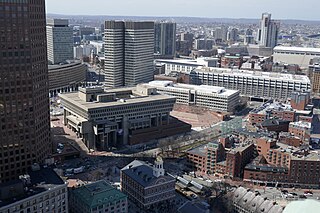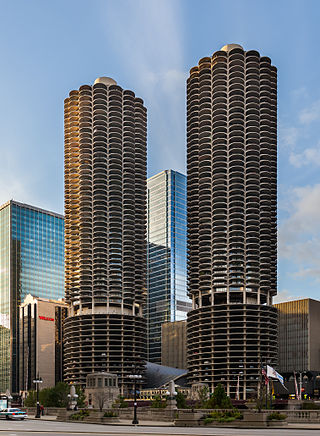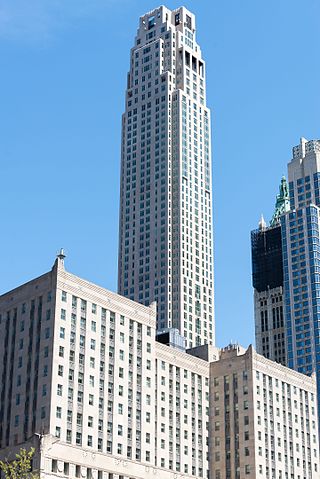
Philip Cortelyou Johnson was an American architect best known for his works of modern and postmodern architecture. Among his best-known designs are his modernist Glass House in New Canaan, Connecticut; the postmodern 550 Madison Avenue in New York City, designed for AT&T; 190 South La Salle Street in Chicago; the Sculpture Garden of the Museum of Modern Art; and the Pre-Columbian Pavilion at Dumbarton Oaks. In his obituary, The New York Times wrote in January 2005 that his works "were widely considered among the architectural masterpieces of the 20th century."

Modern architecture was an architectural movement and style that was prominent in the 20th century, between the earlier Art Deco and later postmodern movements. Modern architecture was based upon new and innovative technologies of construction ; the principle functionalism ; an embrace of minimalism; and a rejection of ornament.

The Seagram Building is a skyscraper at 375 Park Avenue, between 52nd and 53rd Streets, in the Midtown Manhattan neighborhood of New York City. Designed by Ludwig Mies van der Rohe along with Philip Johnson, Ely Jacques Kahn, and Robert Allan Jacobs, the high-rise tower is 515 feet (157 m) tall with 38 stories. The International Style building, completed in 1958, initially served as the headquarters of the Seagram Company, a Canadian distiller.

Marina Abramović is a Serbian conceptual and performance artist. Her work explores body art, endurance art, the relationship between the performer and audience, the limits of the body, and the possibilities of the mind. Being active for over four decades, Abramović refers to herself as the "grandmother of performance art". She pioneered a new notion of identity by bringing in the participation of observers, focusing on "confronting pain, blood, and physical limits of the body". In 2007, she founded the Marina Abramović Institute (MAI), a non-profit foundation for performance art.

Government Center is an area in downtown Boston, centered on City Hall Plaza. Formerly the site of Scollay Square, it is now the location of Boston City Hall, courthouses, state and federal office buildings, and a major MBTA subway station, also called Government Center. Its development was controversial, as the project displaced thousands of residents and razed several hundred homes and businesses.

Postmodern architecture is a style or movement which emerged in the late 1950s as a reaction against the austerity, formality, and lack of variety of modern architecture, particularly in the international style advocated by Philip Johnson and Henry-Russell Hitchcock. The movement was introduced by the architect and urban planner Denise Scott Brown and architectural theorist Robert Venturi in their 1972 book Learning from Las Vegas. The style flourished from the 1980s through the 1990s, particularly in the work of Scott Brown & Venturi, Philip Johnson, Charles Moore and Michael Graves. In the late 1990s, it divided into a multitude of new tendencies, including high-tech architecture, neo-futurism, new classical architecture, and deconstructivism. However, some buildings built after this period are still considered postmodern.

Robert Arthur Morton Stern, is a New York City–based architect, educator, and author. He is the founding partner of the architecture firm, Robert A. M. Stern Architects, also known as RAMSA. From 1998 to 2016, he was the Dean of the Yale School of Architecture.

Marina City is a mixed-use residential-commercial building complex in Chicago, Illinois, United States, North America, designed by architect Bertrand Goldberg. The multi-building complex opened between 1963 and 1967 and occupies almost an entire city block on State Street on the north bank of the Chicago River on the Near North Side, directly across from the Loop. Portions of the complex were designated a Chicago Landmark in 2016. The towers' symbolic similarity to rural Illinois corncobs has often been noted in media.

The Glass House, or Johnson house, is a historic house museum on Ponus Ridge Road in New Canaan, Connecticut, built in 1948–49. It was designed by architect Philip Johnson as his own residence. It has been called his "signature work".

550 Madison Avenue is a postmodern skyscraper on Madison Avenue between 55th and 56th Streets in the Midtown Manhattan neighborhood of New York City. Designed by Philip Johnson and John Burgee with associate architect Simmons Architects, the building is a 647-foot-tall (197-meter), 37-story office tower with a facade made of pink granite. It was completed in 1984 as the headquarters of AT&T Corp. and later became the American headquarters of Sony. A four-story granite annex to the west was demolished and replaced with a shorter annex in the early 2020s.
Beekman Place is a small street located in the Turtle Bay neighborhood on the East Side of Manhattan, New York City. Running from north to south for two blocks, the street is situated between the eastern end of 51st Street and Mitchell Place, where it ends at a retaining wall above 49th Street, overlooking the glass apartment towers at 860 and 870 United Nations Plaza, just north of the headquarters of the United Nations. "Beekman Place" also refers to the small residential enclave that surrounds the street itself. It is named after the Beekman family, who were influential in New York City's development.

The Four Seasons Hotel New York Downtown, also known as 30 Park Place, is a hotel and residential skyscraper in Tribeca, Manhattan, New York City. At 926 feet (282 m), the tower is one of the tallest residential buildings in Lower Manhattan. The top floors of the 82-story building, known as the Four Seasons Private Residences New York Downtown, have 157 residences, ranging from one to six bedrooms, all reached through a dedicated residential lobby at 30 Park Place. Below is a 189-room Four Seasons Hotel, with its own lobby on Barclay Street, which opened in September 2016.
Peter Morgan Pennoyer FAIA is an American architect and the principal of Peter Pennoyer Architects, an architecture firm based in New York City. Pennoyer, his four partners and his fifty associates have an international practice in traditional and classical architecture, or New Classical Architecture. Many of the firm's institutional and commercial projects involve historic buildings, and the Institute of Classical Architecture & Art has stated that the firm's strength is in "deftly fusing history and creative invention into timeless contemporary designs."

3333 Broadway is a group of five apartment buildings ranging from 11 to 35 stories at Broadway between West 133rd and 135th Streets, in Manhattanville, Manhattan, New York City, United States. Completed in 1976, it was the largest residential structure in the United States. Together, the five buildings include 1,193 apartment units. The present manager of the property is the Urban American Management Corporation.

Annabelle Selldorf is a German-born architect and founding principal of Selldorf Architects, a New York City-based architecture practice. She is a fellow of the American Institute of Architects (FAIA) and the recipient of the 2016 AIANY Medal of Honor. Her projects include the Sunset Park Material Recovery Facility, Neue Galerie New York, The Rubell Museum, a renovation of the Sterling and Francine Clark Art Institute, David Zwirner's 20th Street Gallery, The Mwabwindo School, 21 East 12th Street, 200 11th Avenue, 10 Bond Street, and several buildings for the LUMA Foundation's contemporary art center in Arles, France.

Abington House is a residential building in Chelsea, in Manhattan, New York City just outside the Hudson Yards Redevelopment Project. There are 386 rental apartments at the building, located at the southwest corner of 30th Street and Tenth Avenue. Robert A.M. Stern Architects designed the building, and The Related Companies developed the building. There is about 7,200 square feet (670 m2) of rental space on the ground floor of the 33-story, 325 feet (99 m)-tall building; the building also has a pre-fabricated red brick facade. The building, the first to open in the area under the zoning of the Hudson Yards Redevelopment Project, has 78 permanent units. It started leasing in April 2014, two years after beginning construction in 2012.
Hill West Architects is a New York City based architecture firm which works on the planning and design of high-rise residential and hospitality buildings, retail structures and multi-use complexes. They have participated in the design of prominent structures in the New York City metropolitan area. The firm was founded in 2009 by Alan Goldstein, L. Stephen Hill and David West.

The Copper are a pair of luxury residential skyscrapers in the Murray Hill neighborhood of Manhattan in New York City. The buildings were developed by JDS Development and were designed by SHoP Architects with interiors by SHoP and K&Co. The buildings are one of several major collaborations between JDS and SHoP; others include 111 West 57th Street, also in Manhattan, and The Brooklyn Tower in Brooklyn.
Sunset Park Material Recovery Facility is a recycling facility at the South Brooklyn Marine Terminal in the Sunset Park neighborhood of Brooklyn, New York, United States. Operated by Sims Municipal Recycling, it was designed by Annabelle Selldorf, and its construction involved the use of a variety of recycled materials. The campus contains several structures, including an education center and New York City's first commercial-scale wind turbine. As of January 2022, it is the largest commingled recycling facility in the United States and the primary recycling center in New York City.

















